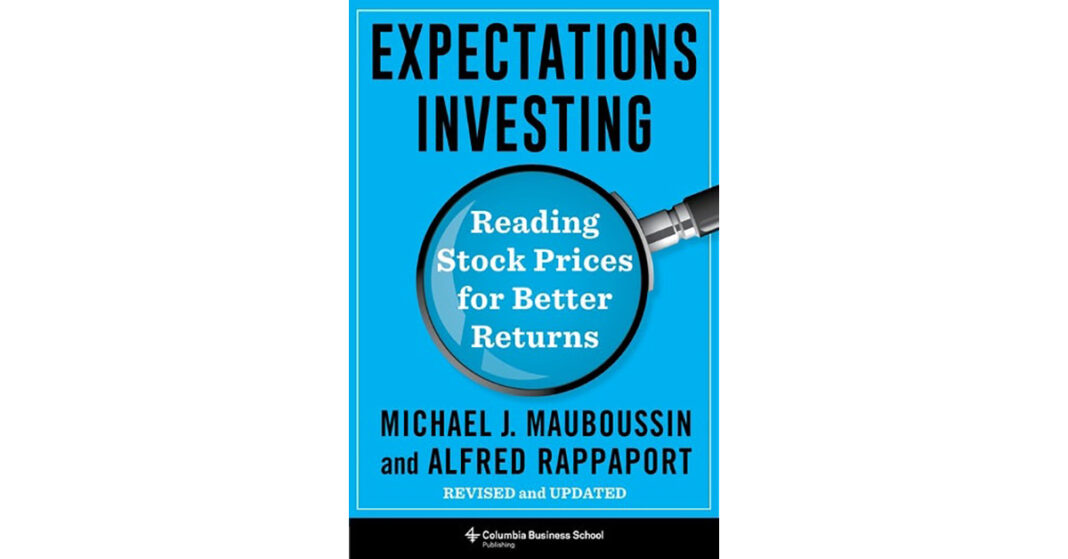Expectations Investing: Reading Stock Prices for Better Returns. 2021 – Revised and Updated. Michael J. Mauboussin and Alfred Rappaport. Columbia Business School Publishing.
Expectations Investing: Reading Stock Prices for Better Returns represents an important resource for practitioners seeking an insightful alternative approach to identifying discrepancies between price and value. This volume is a revised and updated version of the 2001 book authored by Michael J. Mauboussin, head of Consilient Research at Counterpoint Global, Morgan Stanley Investment Management, and adjunct professor of finance at Columbia Business School, and Alfred Rappaport, Leonard Spacek Professor Emeritus at Northwestern University’s Kellogg School of Management.
The current version reflects the many changes in accounting and the business landscape since the original was published. For example, the new edition displays an increased focus on disruption and the value it creates and destroys as well as expanded attention to user / subscriber platforms, which are exploitable for profit and provide optionality. Other changes in the investment world addressed in this update include a shift from active to passive investing, the rise of intangible investments, and a redirection of capital from public to private equity.
The authors argue that investors should begin with a company’s stock price and ask what it implies for future financial results. They provide a guide to strategic and financial analysis to help investors assess the probability of revisions to these expectations. Their framework follows value creation from the triggers that shape a company’s performance to the impact on the value drivers, enabling a practitioner of expectations investing to determine whether to buy or sell a stock. Investors who absorb these lessons will be able to evaluate stocks of companies in any sector / geography more effectively than by utilizing standard approaches. In addition, corporate managers can use the book’s insights to create, modify, and communicate their company’s strategy in the context of shareholder expectations.
Chapters 5, 6, and 7 describe the three steps of the expectations investing process. These chapters represent the core of the book and are all you need to analyze the stocks of most companies.
Chapter 5 outlines the first step, which is estimating the market expectations that justify a company’s stock price. Expectations investing allows you to harness the benefits of the discounted cash flow (DCF) model without requiring you to forecast long-term cash flows. You must understand clearly where expectations stand today before you can consider the likelihood and magnitude of expectations revisions.
Chapter 6 integrates the tools from prior chapters to identify potential revisions from current expectations, which form the basis for investment opportunities. Four building blocks constitute the foundation for identifying expectations opportunities: Historical results and PIE (price-implied expectations) provide the data, while competitive strategy analysis and the expectations infrastructure furnish the analytical tools.
Chapter 7 establishes standards for decisions to buy, sell, or hold a stock — the final step of the process. The magnitude of any excess return depends on how much of a discount a stock trades at relative to its expected value and how long the market takes to revise its expectations. The greater the stock price discount and the sooner the market revises its expectations, the greater the return.
By going beyond DCF valuation to analyze real options, Chapter 8 is an important read for analysts and investors. It provides both a tool that can be used to improve the determination of intrinsic value and practical ways of using it. Mauboussin and Rappaport believe that the DCF model is relevant to valuing start-up companies, provided you complement it with a real options analysis. Since the DCF model can understate the value of flexibility, it may lead to a misreading of price-implied expectations for a business with a vast amount of uncertainty. Real options, however, capture the potential value of uncertain future opportunities. The Shopify, Inc., example in this section is a must-read if you are pondering the best way to value certain start-up and technology companies.
In summary, this revised and updated edition provides an insightful framework for identifying gaps between price and value while reflecting the many changes in accounting and business over the past 20 years. The book’s insights and principles will help practitioners, including both investors and company managers, operate more effectively in light of shareholder expectations.
If you liked this post, don’t forget to subscribe to the Enterprising Investor.
All posts are the opinion of the author. As such, they should not be construed as investment advice, nor do the opinions expressed necessarily reflect the views of CFA Institute or the author’s employer.
Professional Learning for CFA Institute Members
CFA Institute members are empowered to self-determine and self-report professional learning (PL) credits earned, including content on Enterprising Investor. Members can record credits easily using their online PL tracker.



